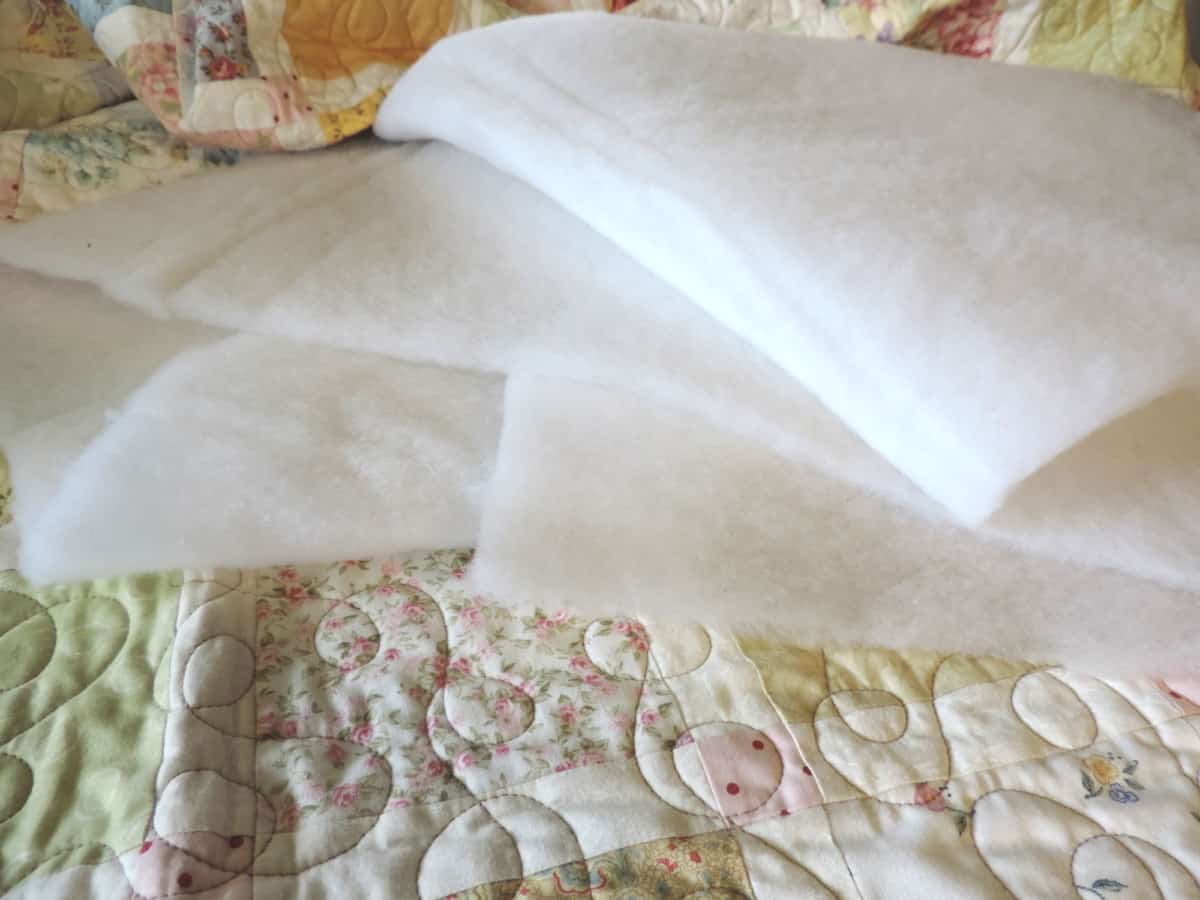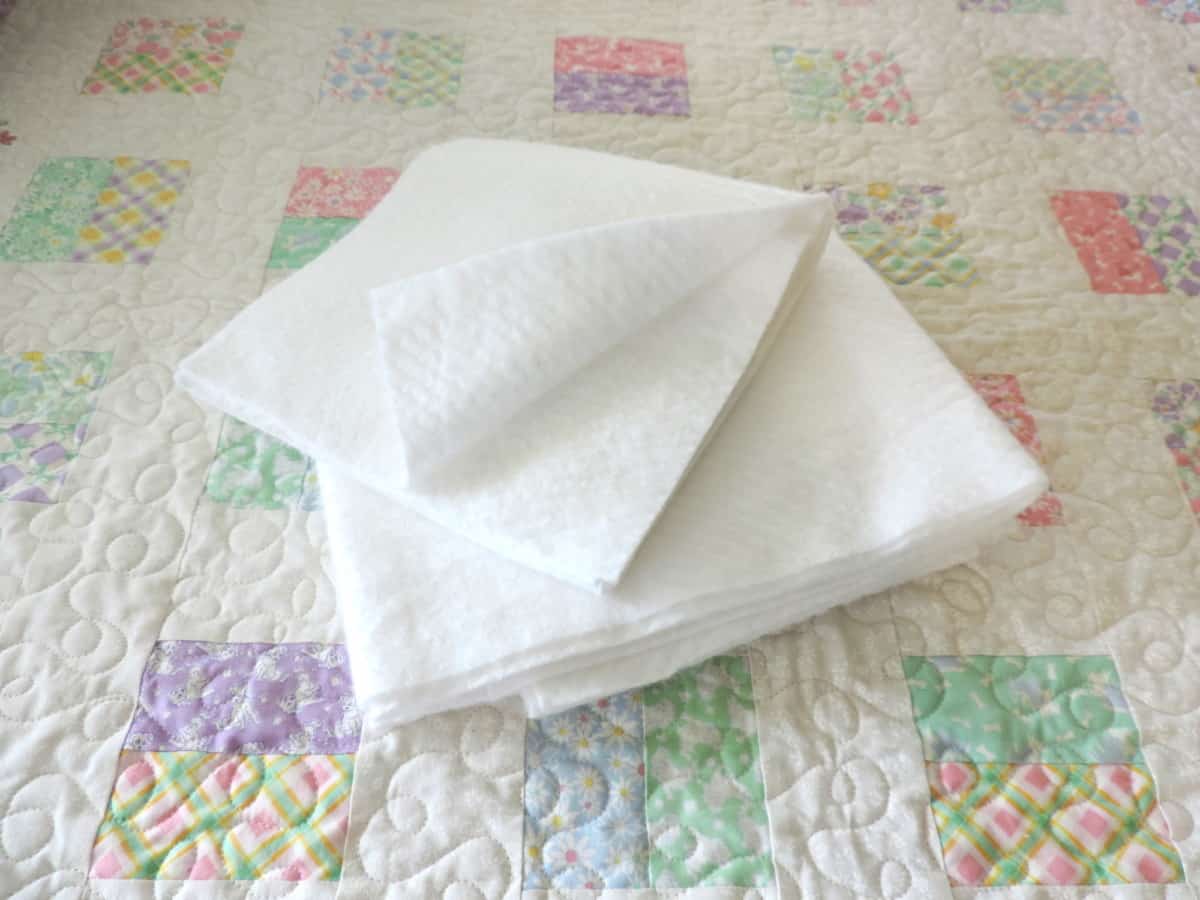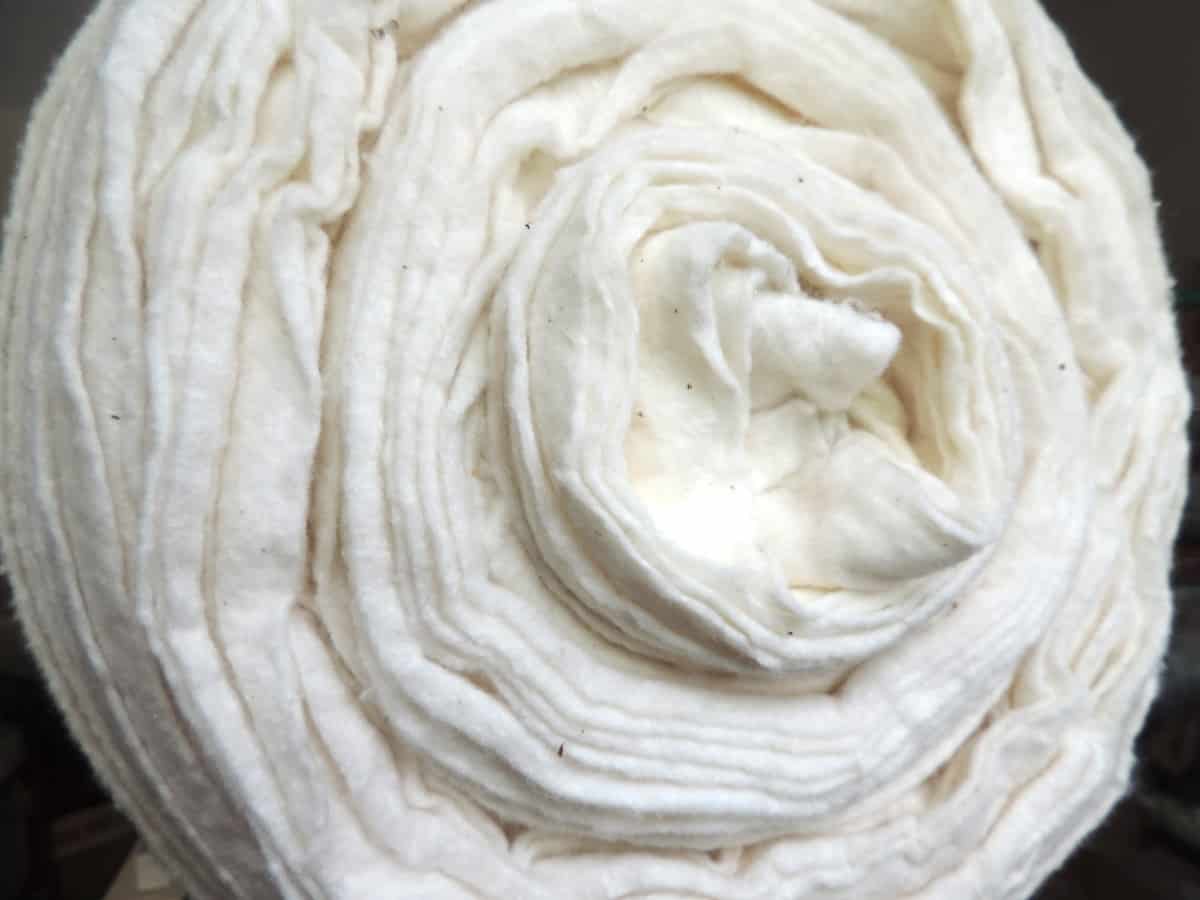You have completed a quilt top and feel a great sense of accomplishment.
And so you should! But now you need a quilt batt and backing fabric to make a quilt sandwich.
What is batting and which one do you choose?
Batting is the soft layer between the quilt top and the quilt backing of a quilt that gives it it’s softness and comfy warm feeling.
There are many choices of batting on the market today to choose from.
So you are faced with deciding which one to use.
To help in making a decision, a few factors play into your choice of batting that will be right for your quilt.
I’ll share many details of what you need to know about quilt batting to make your choice easier.
Basic Questions To Ask Yourself
In deciding what batting you need to use for your quilt, you need to ask yourself a couple of questions.
Quilting Time
What amount of time do you plan to take in quilting your project?
This can be a most important question.
If you are honest and realistic in answering this question, it will help you to decide whether you will hand quilt, machine quilt or tie your quilting project.
Answering this question will help you to determine which battings are most appropriate for your quilt.
Some battings are easier to needle than others and preferred for hand quilting.
Another batting might be more difficult to needle but has more “grip” which would be better for machine quilting.
Some battings require more extensive quilting to keep them stable while others are more stable and require less quilting of any type.
Before selecting a batting, you need to decide on whether you want dense or sparse quilting stitches.
The type of batting you choose dictates the spacing that is recommended between the rows of quilting.
Checking the manufacturer’s label will tell you the maximum distance of the quilting stitches that is recommended for that particular batting.
If this distance is exceeded, the batting will bunch up or shift around causing the finished quilt or project to be less than desirable.
If you decide to tie your quilt, you need to select a batting that will accommodate wide distances between stitches.
Look Of Finished Item
How would you like your finished item to look – flat or puffy?
Because batting comes in various thicknesses and fibers, it can make a quilt that is either flat or puffy, drapable or stiff.
The batting you choose should complement the nature and use of your finished quilt.
Flatter batting is usually used if the quilt or item is going to be displayed against the wall or needs to be drapable.
Puffier or fluffier batting is generally used if more dimension is preferred to highlight the quilting.
For tied projects like comforters, the fluffiest batting is preferred.
The thickness/height or thinness of a batting is called its loft.
High loft battings are the thickest while light or low loft battings are the thinnest.
Cotton batting will give a flatter look and is considered a low loft batt.
Keep in mind that the higher the loft, the less drapability your finished quilt will have.
Natural Or Synthetic Fiber
Many manufacturers have developed battings that are made from cotton and polyester and even blends of both.
You can even find wool, silk, cashmere and alpaca in batting.
Even though polyester, a synthetic fiber, has been the choice of quilters in the past, cotton and other battings made of natural fiber seem to be just as popular these days.
Cotton is non-allergenic while polyester or even wool might be a problem for people that are prone to allergies.
Polyester type batting tends to be thinner than the more dense cotton batting.
Wool tends to be a lighter and fluffier batting.

Polyester Battings
Polyester battings are very lightweight and inexpensive, simple to wash and easy to care for.
They are also easy to needle.
Synthetic fibers have a low level of air permeability, in other words, they are not considered to be “breathable”.
A quilt with polyester batting can contribute to the buildup of body heat if you are using it on a bed.
More sensitive to heat, synthetic fibers are more flammable than natural fibers.
You would not want to use such a batting inside of pot holders or any other item that will come in contact with heat.
A natural reaction of polyester batting is the tendency to “beard”.
Which simply means that tiny fibers poke out through the fabric layers when quilting.
To combat this “bearding”, some battings have been treated to resist this better than others through a process called glazing or bonding.
By the use of chemicals or heat, the loose fibers are sealed to the surface of the batting to help prevent “bearding”.
Hobbs developed a Heirloom Premium Black Cotton Blend (link to read reviews on Amazon) batting that hides these lose fibers against fabrics of a mostly dark quilt.
To create stability, needlepunched batting is a process using needles to mesh or interlock the polyester fibers.
There might initially be more bearding since this type of batting is not generally glazed or bonded.
These fibers will eventually wash or rub off though and the resulting project or quilt is actually more stable when using needlepunched batting.
Polyester batting is resilient, it has the ability to regain its original shape.
It springs back when its unfolded and resists creasing making it a desirable feature for a finished puffy quilt.
Natural Fiber Battings
Natural fiber battings are breathable, making them different than synthetic fibers such as polyester.
Natural fiber battings are also not sensitive to heat and are less flammable.
Having the ability to absorb moisture, cotton battings give cooling comfort in the summer while affording natural warmth during the winter.
Wool battings give warmth without being heavy.
Battings of 100% cotton will give you a more traditional antique flat look to quilts.
Quilts made with cotton battings will be more soft and drapable since cotton battings are low loft.
Since I love the look of antique quilts, my all time favorite batting is Warm & Natural Cotton Batting (link to read reviews on Amazon).
Or Warm & White Cotton Batting (link to read reviews on Amazon).
It’s definitely my go-to batting.
I have always found it to be easy to use, washes up nicely and gives my quilts the look and feel that I and many quilters love.

Cotton battings have improved through the years and come in a variety. Some are natural (unbleached) and some are pure white (bleached).
Older cotton batting needed to be quilted with extremely close intervals to provide stability for the batting as it tended to shift and lump up between the quilting lines.
It was also difficult to needle.
Stability has been provided though in our newer types of batting in a couple different ways such as the following.
- Needlepunching – this process breaks up the density of the cotton fiber that allows for easier needling while also interlocking the fibers.
- To make the batting more stable, some cotton batting is needlepunched into micro-thin polyester scrim (or base).
A batting of this type is the most stable and allows you to quilt or tie your project at 8 to 10 inch intervals.
- Blended cotton battings with 80 percent cotton and 20 percent polyester have just the right amount of polyester to stabilize the cotton fibers.
This allows you to quilt at 3 to 5 inch intervals for most of these types of batting.
Wool batting is another natural fiber batting that’s easily available.
Many quilters have said that this type of batting “quilts like butter”.
There are many advantages when using wool battings.
Wool is very lightweight, it’s breathable and very easy to use when hand or machine quilting.
You might find that wool will beard due to static but it shouldn’t be much of a problem.
Wool batting is a soft and drapable low loft batting.
Wool being a natural insulator, this type of batting is very warm.
So if you need a really warm quilt, you might prefer using a wool batt.
Quilter’s Dream Wool Batting (link to read reviews on Amazon) is a great wool batting.
Another good one is Hobbs Tuscany Washable Wool Batting (link to read reviews on Amazon).
Batting Qualities
By carefully reading the manufacturer’s label for the different battings, you can learn the specific qualities of the one you plan to use.
Loft
The loft of batting refers to the thickness of it.
The appearance of the finished quilt is determined by the loft.
You will get different results from the various loft levels.
Choosing a loft that is compatible with your finishing method will give you better results.
You need to keep in mind that the higher the loft of the batting, the less drapability you will get in your finished quilt.
Drapability
The density or sparseness of the quilting as well as the loft of the batting is what determines how well the quilt will drape.
It also determines the stiffness or softness of the quilt.
Thinner batting with more dense quilting will generally result in a quilt with a softer drape.
Thicker batting in a quilt that is being tied instead of being heavily quilted will usually have less drape.
Grain Line
Just like fabric, that has a grain line, so do battings.
As in fabric, the lengthwise grain is stable and doesn’t have much give while the crosswise grain will be somewhat stretchy.
With this in mind, in order to prevent any unwanted distortion of your quilt, you need to match the batting’s lengthwise grain with the backing fabric’s lengthwise grain.
Quilting the lengthwise grain first will help to limit distortion of your quilt.
Resilience
The batting’s ability to regain its original shape is called resilience.
Polyester battings are resilient since they spring back to their original shape when unfolded and also resist creasing.
Resilience from polyester type battings are desirable for finished quilts where you want a puffy appearance.
Cotton battings are more prone to creasing because they are less resilient.
Some of their other qualities can compensate for this, making them desirable to use.
In terms of resilience, a cotton/polyester blend batting is found somewhere in between.
Washability And Shrinkage
Polyester and wool battings resist shrinkage but cotton battings can shrink anywhere from 3 to 5 percent.
Most quilters use cotton batting without washing it.
Checking the manufacturers label will help in deciding whether or not to preshrink a batting.
Many quilters like me prefer not to wash cotton batting before using it.
When you wash the finished quilt you get a wonderfully puckered antique looking quilt.
This look is actually preferred by many quilters.
What you want your project to look like will determine whether you pre-wash batting or not.
Also keep in mind that if you pre-washed and dried your fabrics you might want to pre-wash cotton batting if you want the layers to have the same shrinkage in the finished project.
Size
When choosing the size of the batting that you plan to use, it needs to be larger than the quilt top.
This will allow for the take-up that is needed to be put onto a quilting frame and makes for better stabilization while quilting.
There needs to be at least 3 to 4 inches extra extending out past the quilt top on every side.
This can be accomplished by adding 6 to 8 inches to both the length and width measurements of the quilt top.
Batting should complement what your finished quilt will be used for.
Talk with other quilters, check package labels and even consider making test samples to find the batting that’s perfect for your quilting project.

